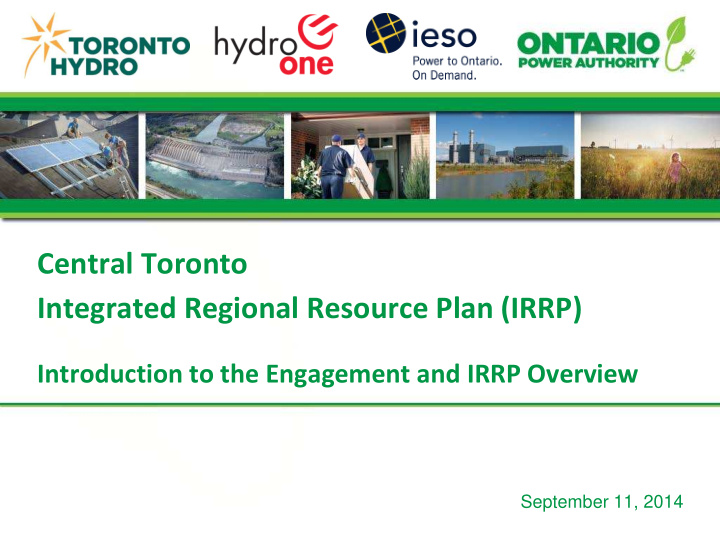



Central Toronto Integrated Regional Resource Plan (IRRP) Introduction to the Engagement and IRRP Overview September 11, 2014
THIS WEBINAR IS THE BEGINNING OF AN ENGAGEMENT PROCESS • Introduction to the Integrated Regional Resource Plan for Central Toronto • Information on opportunities to provide feedback • Answer questions about this plan • A contextual workbook with more information is online 2
THE REGIONAL ELECTRICITY PLANNING PROCESS IN ONTARIO • An Integrated Regional Resource Plan (IRRP) looks at the long term trends for electricity requirements and the different ways to meet the need for: – Capacity to supply demand – Reliability for meeting standards and customer expectations – Supply security for the urban centre • The IRRP is jointly developed by a Working Group – Ontario Power Authority – Toronto Hydro-Electric System Limited – Independent Electricity System Operator – Hydro One Networks Inc. 3
TORONTO IS ONE OF 21 REGIONAL PLANNING AREAS ACROSS ONTARIO Regional Planning Zones 1. Burlington to Nanticoke 11. London Area 2. Greater Ottawa 12. Peterborough to Kingston 3. GTA North 13. South Georgian Bay/Muskoka 4. GTA West 14. Sudbury/Algoma 5. KWCG 15. Chatham/Lambton/Sarnia 6. Metro Toronto 16. Greater Bruce/Huron 7. Northwest Ontario 17. Niagara 8. Windsor Essex 18. North of Moosonee 9. East Lake Superior 19. North/East of Sudbury 10. GTA East 20. Renfrew 21. St. Lawrence
THIS PLANNING PROCESS EXISTS TO SERVE YOUR NEEDS • We want to know: – Your expectations around electricity service – The value you place on higher levels of service – Your preferences around options to meet Toronto’s electricity needs • Your input will help shape the electricity plan • Perspectives may vary based on the type of customer: − Residential, multi-residential, commercial, institutional, etc. 5
ONTARIO’S ELECTRICITY SYSTEM Generation Resources GENERATION TRANSMISSION DISTRIBUTION CUSTOMERS 6
CENTRAL TORONTO IRRP STUDY AREA Metro Toronto (5,000 MW Total Demand, including Central Area) 401 404 400 Central Toronto (2,000 MW, 40% of Metro Toronto) 427 QEW 7
CENTRAL TORONTO IRRP STUDY AREA Demand – Supply • Two major transmission pathways Balance (East and West) 1980s • One source of internal generation (Portlands Energy Centre) Generation 404 401 400 2013 Transmission 427 QEW 8
INFRASTRUCTURE PLANNING IS TARGETED TO ADDRESS THE PEAK DEMAND Toronto Hydro Commercial Load Profile – Peak Summer Day Air Conditioning Lighting Auxiliary Motors Auxiliary Equipment/Plug Loads 9
FORECASTING INVOLVES UNCERTAINTY - A PLAN MUST BE ABLE TO ADAPT TO A RANGE OF POSSIBLE FUTURES 2,600 2,400 2,200 Peak Demand (MW) 2,000 1,800 Factors that can drive demand upward: Actual historic 1,600 • More economic growth peak demand • More people moving into the city 1,400 • Electrification of transportation 1,200 • Less than expected Conservation results 1,000 Factors that can bring demand down: 800 • Shifting to less energy intensive commerce 600 • Reduced pace of growth 400 • Increasing end-use efficiency 200 • More stringent building codes 0 Year 10
THE LOCATION OF GROWTH IS AN IMPORTANT CONSIDERATION IN PLANNING Growth Areas Stations Nearing Capacity 11
A CLOSE UP OF CENTRAL TORONTO’S ELECTRICITY SYSTEM 401 404 400 Central Toronto - Inset Load Transfer Capability Portlands 550 MW 427 QEW 12
THE SYSTEM PERFORMS WELL UNDER MOST NORMAL EQUIPMENT OUTAGES • Some major events have impacted many customers Frequency Statistics Duration Statistics (Interruptions per customer) (Hours per customer - average) BLUE: Without Major Events RED: With Major Events # of outages per customer length of outages in hours per customer on average on average 13
RECENT MAJOR EVENTS July 2013 Rainfall December 2013 Ice Storm 14
OPTIONS FOR MEETING ELECTRICITY DEMAND COST TIMING Transmission & Distribution Distributed Generation OTHERS ?? VISUAL ENVIRON- Conservation IMPACTS & Demand MENTAL Management IMPACTS • Each option has strengths and weaknesses • An integrated plan includes a mix of options Integrated that is affordable and acceptable to the Solutions community and approval authorities 15
CONSERVATION AND DEMAND MANAGEMENT (CDM) OPTIONS • Conservation is an important consideration in regional planning – Opportunity to deploy provincial CDM resources in areas where local electricity needs have been identified – Next generation CDM plans and programs can contribute to regional and community energy planning goals • CDM opportunities for consideration: – Targeted marketing in specific areas with needs – Focusing on programs with greater energy savings at peak – Local demand response and district energy systems – Updating local building codes and standards • Cost and lead time vary based on type of CDM, some programs could be implemented in 1-2 years 16
DISTRIBUTED GENERATION (DG) OPTIONS • DG can contribute to the reliability and security of supply in local areas – Scalable resources can be built up over time • Different types of DG for consideration: – Renewable resources such as solar, wind, biogas/biomass – Combined heat and power systems – Emergency and backup generation • Cost and lead time (2-5 years average) vary based on type of resource 17
TRANSMISSION AND DISTRIBUTION OPTIONS • Wires options can have economies of scale, and significantly contribute to reliability and security • Space for new transmission and distribution is constrained in built up urban areas • Depending on the type of capacity need, options can be: – New load station (s) – Transmission lines and stations • Cost and lead time (5-7 years average) vary based on the type of facility 18
OPPORTUNITIES TO PROVIDE FEEDBACK • Today’s webinars – September 11 at 2:00 pm and 7:00 pm – An archive of these webinars can be found on OPA’s website • Complete the online workbook – Posted on OPA and Toronto Hydro’s website from September 3 – October 10 for comment • Attend an Open House – September 30 at 3:00 pm and 7:00 pm – Metro Hall Civic Centre, Room 302 • Provide input in writing to the OPA at torontoregionalplan@powerauthority.on.ca 19
QUESTIONS? 20
Recommend
More recommend